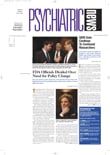Teens around the world seem to face similar mental health challenges—for example, in the number of problems experienced and in girls having more issues than boys (Psychiatric News, September 5, 2003). And now it looks as though they may react to these challenges in a similar manner as well.
In a comparison of Russian and American teens, researchers found that while Russian teens are not exposed to as much violence as American teens, they react to such trauma in similar ways.
The study was headed by Vladislav Ruchkin, M.D., Ph.D., a Russian-educated psychiatrist who came to the United States in 1999 as a Fullbright scholar and who now works as an associate research scientist at the Yale University Child Study Center. The investigation was a collaborative research effort between the child study center's Program on International Child and Adolescent Mental Health and Northern State Medical University in Arkhangelsk, Russia.
For the past decade or so, Russia has been experiencing a painful transition to a capitalist society. These changes have been accompanied by higher crime rates and an increase in community violence, prompting the question of whether DSM-IV criteria for posttraumatic stress disorder can be used to diagnose severe reactions to trauma in Russia. In other words: Do Russians react similarly to Americans where trauma is concerned? No study appears to have tackled the question.
Ruchkin and his colleagues selected about 1,000 teens from New Haven, Conn., and about 1,000 teens from Arkhangelsk to participate in their investigation. New Haven has a high proportion of residents with low socioeconomic status. So does Arkhangelsk.
Subjects were asked to respond in writing to a survey administered on a particular school day. The questions were derived from the Screening Survey of Exposure to Community Violence, the Child Post-Traumatic Stress Reaction Index, the Behavioral Assessment System for Children, and several other sources.
The first instrument evaluated subjects' exposure to community violence during the previous two years. The second instrument examined whether, in the face of a broad range of traumatic events, they had experienced no posttraumatic stress, moderate posttraumatic stress, or severe posttraumatic stress. A score of 40 or higher has been highly correlated with a DSM-IV diagnosis of posttraumatic stress disorder. The third yardstick, the Behavior Assessment System for Children, was used to assess subjects for anxiety, depression, and somatization.
When investigators compared the survey results, they found that more American than Russian teens had been exposed to violence. Also, more American teens than Russian ones had experienced posttraumatic stress. Nonetheless, both American and Russian teens who had experienced posttraumatic stress displayed symptoms in all three domains crucial for a DSM-IV diagnosis of posttraumatic stress disorder—re-experiencing, avoidance, and arousal.
Moreover, both groups showed increasing levels of symptoms with increasing incidents of trauma exposure. Finally, posttraumatic stress disorder is known to be accompanied often by other kinds of mental illness, especially when the trauma has been especially excruciating. This was found to be the case in Russian teens as well as American ones.
The implications of these findings for American psychiatrists, Ruchkin said in an interview, “is that PTSD extends across cultural barriers and that adolescents in other countries experience symptoms in a similar way as they do in the United States.”
The lesson for Russian psychiatrists, he added, is that even though a diagnosis of posttraumatic stress disorder was, until recently, absent from official classification in Russia, obviously Russian teens “experience symptoms as a result of exposure to traumatic events much in the same way” that American teens do.
So there is a need in Russia, he concluded, “for developing treatment and rehabilitation approaches for those suffering from posttraumatic stress (and perhaps, first of all, applying those approaches that demonstrated their effectiveness in the United States).”
The study was funded by the William and Flora Hewlett Foundation.
Am J Psychiatry 2005 162 538
